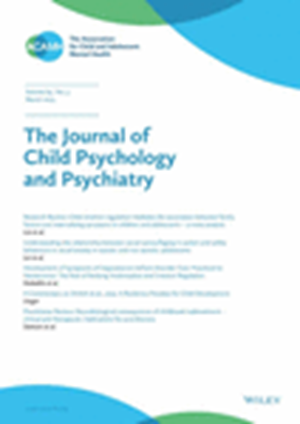Research Review: What we have learned about early detection and intervention of borderline personality disorder
IF 6.5
1区 医学
Q1 PSYCHIATRY
引用次数: 0
Abstract
BackgroundBorderline personality disorder (BPD) typically emerges during adolescence and early adulthood and has severe personal, social and economic consequences. Despite significant research efforts on early intervention over the past two decades, delays in diagnosis and treatment are still common, and exclusion of individuals with BPD from mental health services is prevalent.MethodsIn order to bridge the gap between research and clinical practice, this review qualitatively synthesises empirical evidence on early intervention for BPD, addressing four key questions: (1) Should BPD be diagnosed in adolescents? (2) How is BPD diagnosed in adolescents? (3) Is adolescent BPD treatable, and how effective are treatments? and (4) Can BPD development be prevented?FindingsEvidence supports diagnosing BPD in adolescents from the age of 12 years, with validated diagnostic measures available. While outpatient, disorder‐specific psychotherapy has shown efficacy in reducing BPD symptoms and self‐harm in youth, the evidence is limited by the small number of randomised controlled trials (RCTs), small sample sizes, heterogeneous inclusion criteria, varying control interventions and high risk of bias. Indicated prevention targeting subthreshold BPD symptoms shows promise, but further research is needed on selective and universal prevention strategies.ConclusionsEnhancing healthcare professionals' knowledge about early diagnosis and treatment for BPD appears necessary in order to reduce the reluctance to diagnose the disorder in adolescence, which is recommended by many national treatment guidelines today. Additionally, large‐scale, rigorous RCTs are necessary to establish the superiority of disorder‐specific treatments over standard care and explore novel service models that offer easily accessible and scalable evidence‐based care for young people with BPD features.研究综述:我们对边缘型人格障碍的早期发现和干预的了解
边缘型人格障碍(BPD)通常出现在青春期和成年早期,具有严重的个人、社会和经济后果。尽管在过去的二十年中对早期干预进行了大量的研究,但诊断和治疗的延迟仍然很常见,并且将BPD患者排除在精神卫生服务之外的情况很普遍。方法为了弥合研究与临床实践之间的差距,本综述定性地综合了BPD早期干预的经验证据,解决了四个关键问题:(1)青少年是否应该诊断BPD ?(2)青少年BPD是如何诊断的?(3)青少年BPD是否可以治疗?治疗效果如何?(4) BPD的发展是否可以预防?研究结果:有证据支持在12岁以上的青少年中诊断BPD,并有有效的诊断方法可用。虽然门诊、特定障碍心理治疗在减少青少年BPD症状和自我伤害方面显示出疗效,但证据受到随机对照试验(rct)数量少、样本量小、纳入标准不一致、不同的对照干预措施和高偏倚风险的限制。针对阈下BPD症状的指示性预防显示出希望,但需要进一步研究选择性和普遍的预防策略。结论提高医护人员对BPD早期诊断和治疗的认识是必要的,以减少青少年对BPD的不情愿诊断,这是当今许多国家治疗指南所建议的。此外,大规模、严格的随机对照试验是必要的,以确定障碍特异性治疗优于标准治疗,并探索新的服务模式,为具有BPD特征的年轻人提供易于获取和可扩展的基于证据的护理。
本文章由计算机程序翻译,如有差异,请以英文原文为准。
求助全文
约1分钟内获得全文
求助全文
来源期刊
CiteScore
13.80
自引率
5.30%
发文量
169
审稿时长
1 months
期刊介绍:
The Journal of Child Psychology and Psychiatry (JCPP) is a highly regarded international publication that focuses on the fields of child and adolescent psychology and psychiatry. It is recognized for publishing top-tier, clinically relevant research across various disciplines related to these areas. JCPP has a broad global readership and covers a diverse range of topics, including:
Epidemiology: Studies on the prevalence and distribution of mental health issues in children and adolescents.
Diagnosis: Research on the identification and classification of childhood disorders.
Treatments: Psychotherapeutic and psychopharmacological interventions for child and adolescent mental health.
Behavior and Cognition: Studies on the behavioral and cognitive aspects of childhood disorders.
Neuroscience and Neurobiology: Research on the neural and biological underpinnings of child mental health.
Genetics: Genetic factors contributing to the development of childhood disorders.
JCPP serves as a platform for integrating empirical research, clinical studies, and high-quality reviews from diverse perspectives, theoretical viewpoints, and disciplines. This interdisciplinary approach is a key feature of the journal, as it fosters a comprehensive understanding of child and adolescent mental health.
The Journal of Child Psychology and Psychiatry is published 12 times a year and is affiliated with the Association for Child and Adolescent Mental Health (ACAMH), which supports the journal's mission to advance knowledge and practice in the field of child and adolescent mental health.

 求助内容:
求助内容: 应助结果提醒方式:
应助结果提醒方式:


